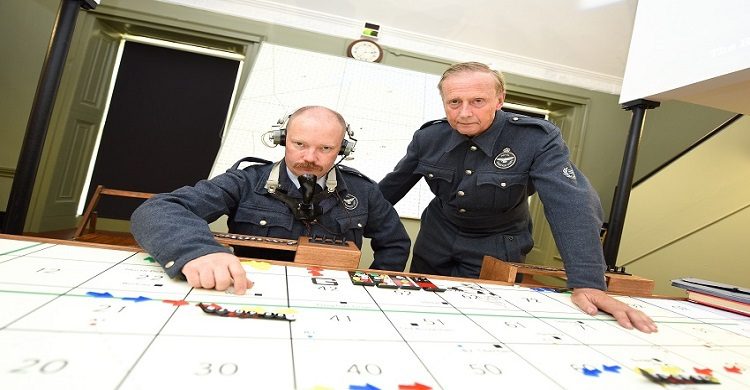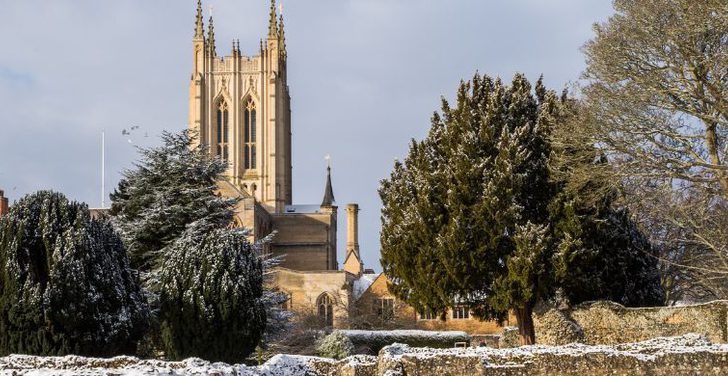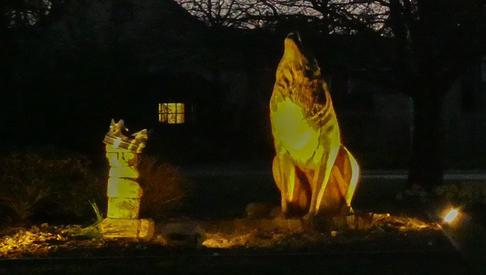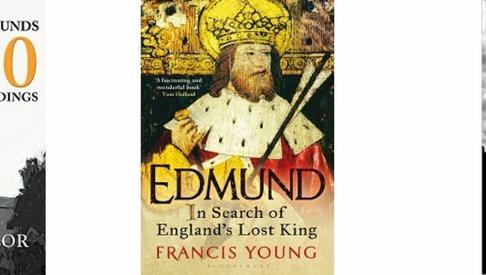
Back to Blogs
Discover
In Bury St Edmunds - Look Up!
Bury St Edmunds is a town full of history and architecture. But don't just look in front of you - remember to look up as many of our hidden gems, untold history and exciting finds are above eye-level!
Compiled with help and grateful thanks from Historian and Author Martyn Taylor.
Muses of the Grand Theatre at Market Cross

Look up and you can find four wonderful carvings of muses on the side of The Market Cross in The Traverse, facing The Cornhill.
Markets have been held in Bury St Edmunds for more than a thousand years and still thrive today, with markets on Wednesdays and Saturdays. Even today, the street names recall their history (for example Buttermarket, Cornhill, Woolhall and Hatter Street) describing the goods traded there - butter, corn, wool, hats.
In June 1725, the first floor of The Market Cross became Bury St Edmunds’ first permanent theatre, The Grand Theatre before Theatre Royal Bury St Edmunds was founded. In 1774 the famous Georgian architect, Robert Adam was commissioned to re-clad the south end of The Market Cross. The scheme was later enlarged to include the other three sides and work was finally completed in 1780, although the town had been using the first floor as a theatre for four years. Now it is home to a performing arts and arts centre!
Look to The Stars at The Athenaeum

Tucked away within the green dome on top of The Athenaeum is one of only two astronomical observatories in Suffolk complete with a Victorian Troughton & Simms 4-inch refracting telescope.
The observatory was built after an inspiring astronomy lecture at The Athenauem by Sir James Airy, 7th Astronomer Royal, in October 1858, at the same time the impressive Donati’s comet was looming large in the night sky.
Unfortunately the observatory is not currently open to the public as it is in need of restoration but The Athenaeum Astronomy Association has started fundraising to restore the observatory to its former glory.
Missing Statues from the Abbey Gate

If you look closely at the front of Abbey Gate at the entrance to the Abbey Gardens you will see a number of arches with empty plinths.
It is believed that these were once filled with statues to various saints but they were taken during the dissolution of the Abbey.
Academic Montague Rhodes James (known more widely as M.R. James the ghost writer) put forward a theory in his book 'Suffolk and Norfolk', that the three niches immediately above the portcullis in the centre of the gate may have contained St Edmund and two archers. Look carefully, and you will see the one in the centre is raised slightly higher than the other two, possibly indicating the significance and importance of the central statue!
St Edmundsbury Cathedral's Fan Vaulted Ceiling

A trip to St Edmundsbury Cathedral is a must do in Bury St Edmunds. When you go inside be sure to look up at the magnificent gilded fan vaulted ceiling of the Millennium Tower.
The fan-vaulted ceiling, made of oak, gilded and painted in blue, green and red, weighs about 6 tonnes and was hoisted in large, rib structure components 45 metres from the crossing floor. When hoisted and in its final position under the tower roof, craftsmen climbed up onto scaffolding to fix moulded frames and panels into the rib structure to make the finishing touches.
The base of the tower is adorned with 42 Diocesan shields, each bearing their coat of arms.
Saint Edmund Looks Upon His Town Above The Boosh Bar

If you stand facing the entrance of 2 Abbeygate Street, now Boosh Bar, and look up you will see a niche above the entrance which contains a statue of St Edmund. The statue dates from around 1887 but previous to St Edmund another saint was celebrated here.
Up until 1969 this building was the premises of Thomas Cross, seedsman, nurseryman and florist. The saint that was originally in the niche was that of St Phocas, patron saint of gardeners.
Pineapples at Lloyd's Bank

The hanging sign above Lloyds Bank in Buttermarket is rather special. It features two pineapples which heralded from a time when pineapple was an expensive and rare fruit and to offer it to your guests showed your prosperity and generosity. On top you will see an oak tree for the Oakes family. James Oakes founded a successful banking business in the late 18th century. There's also a beehive with a bee argued to stand for Bevan of the Rookery in Rougham, which later became Ravenwood Hall (now Ravenwood Hall Hotel). But it is more likely that when Lloyds formed in 1765 they chose a beehive to represent industriousness.
In 1865, Lloyd & Co took over another bank in 1884 that had a black horse as a symbol. So why all these symbols combined in one sign? In 1918, they acquired the Bury firm Capital & Counties Bank, which had a few years earlier combined with Oakes, Bevan and Tollmache & Co.
Related Posts
Related Blogs

News
Bury Tour Guides to launch…
Bury St Edmunds Tour Guides to Introduce new tours in…

News
Town’s Museum Forms New…
Moyse’s Hall Museum will be forging links with a…

News
St Edmundsbury Cathedral…
St Edmundsbury Cathedral in Bury St Edmunds is…

News
Bury St Edmunds & Beyond…
Step inside many of Bury St Edmunds historic buildings…

News
Bury's Best Pubs with a Past
some notable, historic and somewhat quirky pubs and…
Latest news

News
Bury Tour Guides to launch new tours next year after successful 2025
Bury St Edmunds Tour Guides to Introduce new tours in 2026 and continue the successful Food and Drink Tours!

News
New in Bury St Edmunds For 2026
A sneak peak into new attractions visitors can enjoy in Bury St Edmunds in 2026.

News
Baby It's Cold Outside... Things To Do When the Weather Turns Frosty
Just because the temperature’s dropped doesn’t mean the fun has to! If you’re visiting town during the chillier months, there’s still plenty to see, do, and experience.

News
Christmas Park and Walk 2025

News
Festive Theatre Guide 2025

News
Festive Markets in Bury St Edmunds
Festive markets are set to bring seasonal cheer to Bury St Edmunds this November and December, offering the perfect chance to pick up all of your Christmas essentials!

News
Savour The Winter Season in Bury St Edmunds
Ways to mark the winter season in Bury St Edmunds

News
Where to see fireworks in and around Bury St Edmunds
If you're visiting Bury St Edmunds around bonfire night here’s our roundup of some of the best celebrations in Bury St Edmunds and the surrounding towns and villages.

News
Town’s Museum Forms New Partnership with US Museum
Moyse’s Hall Museum will be forging links with a museum in Salem Massachusetts as part of a project to explore the shared history of the infamous witch trials.



